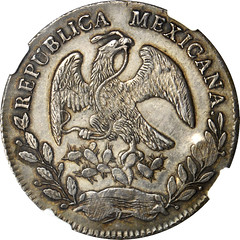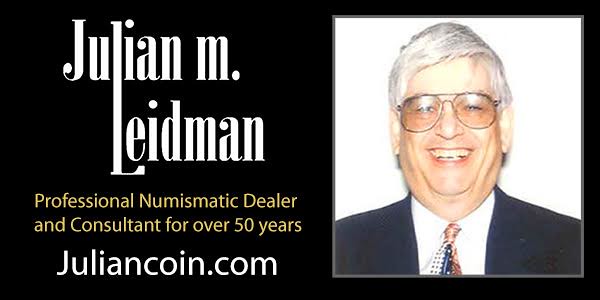
PREV ARTICLE
NEXT ARTICLE
FULL ISSUE
MEXICAN 8 REALES BETWEEN AMERICA AND JAPANKyle Ponterio writes: I saw the article from Dan Owens about the 1859-S coinage and trade with China and Japan. I have heavily researched the time period he is talking about, but on the Japanese side from the American perspective. Please find attached an article that I wrote that was published in the US-Mexican Numismatic Association Journal in December 2015 along with a picture of an example of the subject matter. Thanks! I forwarded the full article to Dan Owens. Here's an excerpt. -Editor
  After nearly two years, on July 29, 1858, the treaty of Amity and Commerce was signed at Edo, but was not to come into full effect until July 4, 1859, in accordance with Article XIV. Lord Elgin, who was negotiating the British treaty, was not particularly happy with the date chosen for the American treaty to take full effect so he chose July 1 for the British treaty, causing it to take effect first. Harris’ hard work finally paid off when he was able to resolve several of the outstanding issues from Perry’s first treaty, such as the questions of currency and residency. Article III of the new treaty permitted the opening of additional ports allowing American citizens to permanently reside at such places as Kanagawa, opened July 4, 1859. On June 30, in anticipation of the opening of the new ports, the consulate was moved from Shimoda to Yokohama. On the July 7, accompanied by 23 fellow Americans, Harris established the American legation. The article also stated that six months after the opening of Yokohama, Shimoda was to be closed as it was not big enough to support trade and was surrounded by mountains, isolating it from the rest of the country. The issue of currency was high on the priority list of all the foreign diplomats, and Harris was no exception. As early as September 1856 he had suggested that the exchange of coins should be based on weight. The Japanese argued that their coins contained more alloy than foreign coins and at first wanted a 25% discount to pay for the re-coining of foreign coins. Harris countered that 5% was sufficient and that the cost in Europe or America was less than 1%. He stated that he could employ a competent moneyer from the United States for 5% or less. He also informed them that he was aware of their long history of debasing currency. After this last point was brought to their attention, the Japanese relented and agreed that there should be a 6% discount to cover the cost of reminting foreign coins. Article V of the new Harris treaty states: “Americans and Japanese may freely use foreign coin in making payments to each other” and “All foreign coins shall be current in Japan, and pass for its corresponding weight of Japanese coin of the same description”. This article also states that for a period of one year after the opening of each harbor, Americans would be able to exchange coins, weight for weight, without penalty of discount. This was apparent in the port of Hakodate where foreign coins were countermarked with Japanese numerals specifying their weight accurate to less than 1% (however, the subject of Hakodate countermarks is for another time). It also stated that with the exception of Japanese copper coins, “coins of all descriptions may be exported from Japan, and foreign gold and silver un-coined”. After the opening of Yokohama and the stipulations of exchange (as stated in Article V) denoting where coins were to circulate, weight for weight, the coins of the realm (“Mexican dollars”) were to be stamped at the customs house. The individual stamps Aratame, San, Bu and Sada were hand applied to the cap side of the “Mexican dollars”, meaning they have been determined to be worth three bu of silver. Merchants were now able to go to the customs house and obtain Japanese currency to conduct trade. They could exchange one “Mexican dollar” for three Ichibu, or on a larger more accurate scale 100 “Mexican dollars” to 311 Ichibu, minus the percentage stated in Article V. This provided an aggregate profit of about 70% on the exchange of four Ichibu for one gold Koban, which was worth about 12 “Mexican dollars” outside of Japan. The exchange rate in Japan of gold to silver was approximately 1:5 and was disproportionate when compared to that of the rest of the world, which used a 1:15 ratio. This resulted in a mass exodus of gold. The increased exchange of Ichibu caused some alarm with officials who tried to limit how much one could receive per day and declared that only a small amount could be exchanged per individual. One documented account tells of Mr. Jack Ketch who applied for the astronomical amount of 1,200,666,777,888,999,222,321 Ichibu to be exchanged, knowing full well that he would only receive a small portion. Another failed attempt by the Japanese to stop the out flow of gold was their issuance of the debased Nishu, which was slightly bigger in size to the Ichibu, but with a purity of about 85% silver. These were not well received by the general populace. It is theorized that the failed attempt to stop the out flow of gold by issuing debased currency led to “Mexican dollars” being re-coined, resulting in the relative scarcity of the Aratame San Bu Sada Gin. There does not seem to be a clear start date for when the “Mexican dollars” were countermarked, but it could not have been before the opening of Yokohama on July 4, 1859. However, there is a very clear end date of May 12, 1860 when production of these pieces ceased. As stated above the countermarks were individually hand applied to the cap side of the “Mexican dollars”. In order by location (reading counterclockwise starting after the fineness) is Aratame (2 o’clock), San (1 o’clock), Bu (12 o’clock), Sada (11 o’clock). It does not appear that these were applied in any specific order, but each character was placed in a very specific location between the rays of the radiant Phrygian cap near the edge. Since these were applied by hand, the exact location in relation to the edge varies from piece to piece. The Howard Gibbs 1859-CCE piece is somewhat of a mint error having the first three countermarks in their usual locations, with sada located between the rays at 10 o’clock. The person applying these countermarks probably applied sada first then realized that it was in the wrong place and applied the other three in their respective locations. What can be ascertained from this is that the countermarks were in fact applied individually with very specific locations for each. As such this would also account for the uneven application of some of the punches. To read the earlier E-Sylum article, see:  Wayne Homren, Editor The Numismatic Bibliomania Society is a non-profit organization promoting numismatic literature. See our web site at coinbooks.org. To submit items for publication in The E-Sylum, write to the Editor at this address: whomren@gmail.com To subscribe go to: https://my.binhost.com/lists/listinfo/esylum All Rights Reserved. NBS Home Page Contact the NBS webmaster 
|